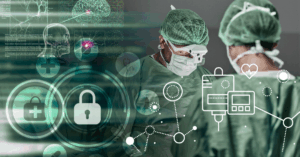How IoMT Security Helps with Medical Device Utilization

Medical device utilization remains one of the most common issues in healthcare delivery organizations (HDOs). Ensuring that all the medical devices and equipment, like mobile infusion pumps, CT scanners, and MRI machines, are in use regularly can be challenging for health technology management (HTM) teams.
The problem is that connected medical devices, or the Internet of Medical Things (IoMT), have added many more devices to track on the network. Cybersecurity teams need to understand how best to defend these technologies from attack, and that’s where IoMT tools excel. The ability of IoMT security tooling to defend connected equipment from attack through key capabilities like inventory creation, vulnerability prioritization, and anomalous behavior detection also has the added benefit of enhancing medical device utilization rates.
Why Medical Device Utilization Remains Challenging
It’s difficult to track where connected medical equipment is physically located in hospitals, especially mobile high-use devices like infusion pumps, much less how often they are used during shifts. HTM teams spend a lot of time tracking down devices when they’re outside central areas for maintenance, and medical staff often do the same to ensure they can provide patient care.
The problem is so acute that 32% of nurses said they often spend over 20 minutes per shift searching for necessary mobile medical devices and frequently lack confidence that they will receive them when required. Similarly, a quarter of nurses in the same study said they felt ill-equipped with the correct supplies and resources when needed for patient care.
One method for resolving the problem is that nurses retain equipment outside of central inventory areas. This widespread unauthorized retention of medical equipment commonly causes interdepartmental friction, and also undermines a hospital’s capability to locate devices for preventative maintenance and recalls. Ultimately, unauthorized retention creates patient safety, compliance, and legal risks while also forcing HTM technicians to routinely expend disproportionate effort trying to find medical devices in obscure areas.
These issues have lead to two out of five pieces of medical equipment being underutilized, according to a Wollega University study. These utilization rates are influenced by device availability, failure rates, availability of trained staff to operate the equipment, and maintenance, including repairs. The underutilization of medical equipment thus leads to wasted budget and limited effectiveness.
The average hospital purchases or rents 20% to 30% more medical devices than they need as a result of unauthorized medical equipment retention. The wasted spend is so bad that hospitals write off hundreds of assets each year because they cannot find them. This compounds the issue of nurses wasting time trying to locate critical medical equipment to provide patient care and HTMs wasting time finding equipment for maintenance. Anywhere from 10% to 20% of hospital assets are permanently lost or stolen each year at an average cost of $3,000 per item, compounding the financial impact to already cash-strapped facilities.
These costs are significant, especially for smaller hospitals. Tools like real-time location sharing (RTLS) can help with locating assets within the facility, which solves the problem of finding devices, but that does nothing to understand how much each device is used. Solving this particular issue is what IoMT security tools can help with.
How IoMT Security Provides Better Device Utilization Statistics
IoMT security solutions are designed to automatically scan hospital networks and identify connected assets as part of building a cohesive inventory. Once the IoMT security tool builds that asset inventory, including device identifiers like MAC address and firmware version, security and HTM teams can leverage that data to discover usage patterns within the hospital.
Unlike RTLS and other location systems, which solve the problem of finding missing equipment within the hospital, IoMT tools generate extensive data around actual device usage, optimal resource allocation, and data necessary for capital planning initiatives.
The accurate usage-based data that IoMT security solutions generate, when analyzed comprehensively, provides valuable intelligence that’s useful in operational and strategic decision-making regarding clinical workflows and asset management, including management of cyber risks.
For example, if HTM teams discover they have 1,500 infusion pumps throughout a 2,000-bed facility, but only 70% of those pumps are regularly used, then they could easily reallocate the underused infusion pumps. On the other hand, if this data shows 100% utilization of all infusion pumps, then HTM teams would have a strong case to purchase more such units.
IoMT security solutions that tracks both device location and device usage enable HTM teams and senior leaders to make more informed decisions about purchasing new equipment as well as optimizing maintenance schedules. Maintenance can easily be scheduled for device downtimes on high-volume and high-criticality equipment, streamlining necessary work.
Thus IoMT security solutions do far more than enable tighter defenses around connected equipment. They can also ensure that hospitals are more efficient and effective at performing their core function of providing patient care.
How Asimily Drives Optimal Medical Device Utilization
The Asimily IoMT Risk Management platform offers granular insight into medical device utilization metrics and device location (when integrated with a hospital’s preferred RTLS solution). Usage data in the Asimily platform empowers hospitals to strategically plan their operations with enhanced visibility into device utilization. This information enables hospitals to optimize quality of care and respond to shifting demand.
The real-time transparency in the Asimily platform provides analytics that facilities can use to maximize medical equipment investment and ensure high device utilization. Pairing utilization tracking with predictive maintenance scheduling ensures that Asimily customers can reduce operational costs and minimize disruptions to patient care.
Medical imaging devices like MRIs and X-ray machines especially are significant capital investments. Ensuring that these systems are fully utilized is vital to maximizing the hospital’s investment. With Asimily’s real-time device network monitoring and medical device utilization capabilities, facilities can better understand usage trends while leveraging that information to improve efficiency. Asimily’s capabilities empower customers to:
- Identify underutilized devices and increasing utilization at a rate of 25% or more through optimized scheduling
- Track study and image counts to inform maintenance/replacement planning, potentially extending equipment lifespan
- Reduce re-setup times using metrics on examined body parts (e.g. head vs. feet for imaging)
- Compare device utilization across locations to pinpoint and remedy inefficient use of under-leveraged devices regardless of geography
- Understand usage patterns and physician ordering habits to refine hours of operation and scheduling
This isn’t exclusive to stationary devices. High-volume fleet medical devices like infusion pumps, patient monitoring systems, and ECG machines present their own unique challenges. Asimily’s usage-based tracking data can ensure customers have the right information at the right time to make key purchasing decisions while driving cost savings and cost avoidance opportunities.
Equipment utilization data can also help finding efficient maintenance windows that avoid obstructing clinical workflows. Data-driven insights into actual usage could thus drive optimized servicing aligned with operational realities. Resources may be focused on needs demonstrated by empirical metrics for maximized uptime at lower cost.
By monitoring usage, HTM personnel can see when devices have low utilization, enabling hospitals to perform maintenance when least disruptive. This ensures an evidence-based approach to maintenance strategy and minimal disruption to patient care delivery.
HTM teams acting as a cost center need a more efficient and meaningful solution for becoming a strategic partner to finance and clinical teams. Effective device utilization information that helps manage operational, financial, and cyber risks is the way to do that. This cannot be achieved with traditional security or location tracking systems, which is why a solution like Asimily that tracks device location on the network and utilization is needed. Asimily empowers HTM teams and their hospital operations to make better capital spending decisions, better cost savings and avoidance opportunities, craft evidence-based preventative maintenance schedules and ultimately deliver the most efficient patient care at the lowest possible cost.
Secure Every IoT Device.
Automatically.
Cyber threats move fast — so should you. Asimily gives instant inventory and smart, prioritized risk mitigation insights for every IoT, OT, and IoMT device — so you can take action before threats strike.




